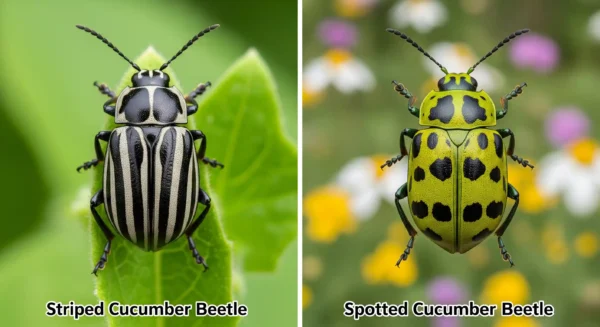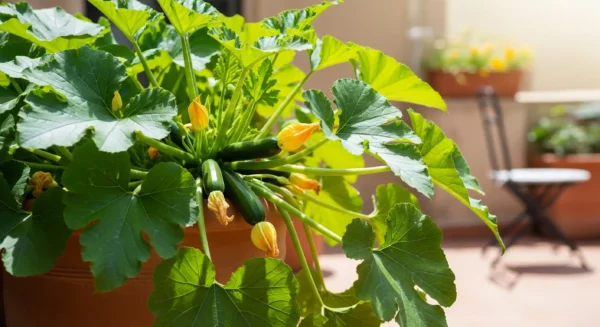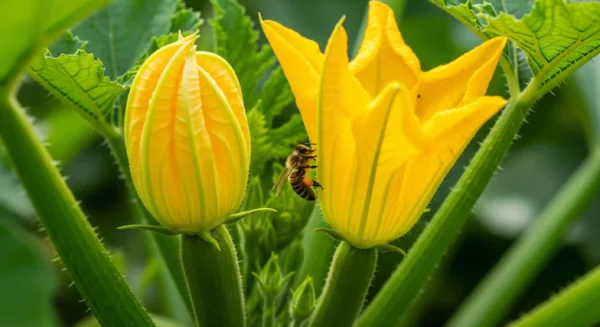Beat Squash Bugs Naturally on Zucchini: Your Organic Guide to Prevention & Control
Having watched your zucchini and squash plants develop from little seedlings into large producers, you have lovingly cared for them. You’re dreaming of grilled zucchini, perhaps some pumpkin pie later in the season… and then you see them. Strange bronze eggs under the leaves, clusters of greyish-brown insects hiding near the base, and perhaps even some sad, wilting vines. Indeed, the squash bugs are here.
Among gardeners cultivating cucurbits—the plant family comprising squash, pumpkins, cucumbers, and melons—these Anasa tristis pests are well-known. Sometimes they can wipe out whole plants; they can multiply fast and cause major damage. One could be tempted to grab for the most potent chemical spray on the shelf!
But wait! You can definitely fight back against squash bugs without using severe pesticides if you are dedicated to organic gardening—perhaps to keep chemicals off your food, protect the essential pollinators visiting those large yellow flowers, or just promote a better garden ecosystem. Though certainly doable, it calls for vigilance and a multi-pronged strategy.
This book aims to be your first source for knowing and controlling squash insects the organic way. Most importantly, we’ll discuss a variety of efficient prevention techniques and organic control tools as well as how to identify them and what drives them. Prepared to naturally protect your squash patch? Let’s get started!
Why Use Organic Techniques for Squash Bugs?
Before we dive into strategies, let’s fast remind ourselves why maintaining organic values is valuable, even when dealing with a persistent pest like the squash bug:
- Food Safety: No concerns about synthetic pesticide residues on the squash you and your family will consume.
- Pollinator Protection: To generate fruit, squash flowers rely quite a bit on bees. Organic techniques are far less likely to harm these vital guests.
- Beneficial Insects: Your garden is teeming with good insects—ladybugs, lacewings, spiders, predatory wasps—that help manage pests naturally. Organic methods help to maintain this advantageous insect population.
- Environmental Health: Avoiding synthetic chemicals helps your soil stay healthier and stops possible runoff into rivers. It’s about cooperating with the ecosystem.
- Plant Resilience: Organic gardening usually stresses developing healthy soil, which results in stronger, more resilient plants better able to resist certain pest pressure.
Organic pest control for squash bugs usually follows Integrated Pest Management (IPM) guidelines: prevent pests where possible, monitor plants closely, and use the least-toxic interventions first when action is required.
Understanding Your Enemy: Spotting Squash Bugs & Their Harm
Knowing precisely who you are dealing with starts effective control.
- Adults: Mature squash bugs are flat-backed, shield-shaped, relatively large (roughly 5/8 inch or 1.5 cm long) insects. Usually dark greyish-brown or nearly black. Especially during the heat of the day, they tend to move slowly and often hide near the base of the plant, under debris, or on the undersides of lower leaves. Crushed, they emit a bad smell (a defensive mechanism).
- Nymphs: Young squash insects known as nymphs undergo several stages—instars. Often in groups, they begin very tiny with light green bodies and dark legs. Growing larger and turning greyish, still with dark legs and antennae, they become Often, they may be found on the undersides of leaves.
- Eggs: Usually laid in tidy clusters or rows, squash bug eggs are tiny, oval-shaped, and often found in the angles created by leaf veins on the undersides of leaves. Usually, they are a unique shiny bronze, copper, or reddish-brown hue. Finding and eliminating these is absolutely vital!
- Damage: Using piercing-sucking mouthparts to draw sap from leaves, stems, and sometimes fruit, both adults and nymphs feed. Soon turning brown and necrotic (dead), the leaves develop tiny yellow patches from this feeding. Heavy feeding can cause whole leaves to wilt, blacken, dry out, and become crispy; this condition is sometimes known as “anasa wilt.” Especially on young plants, serious infestations can make the whole plant wilt and maybe die. They are especially harmful to other winter squash, pumpkins, and zucchini.
Making Your Garden Less Inviting: Prevention First
Dealing with squash bugs organically starts with preventing their establishment in large numbers. Here are some important preventive measures:
- Fall & Spring Cleanup is Essential: Adult squash insects survive the winter by hiding under plant debris, rocks, boards, or in other sheltered areas close to the garden. Cleaning up all squash vines and garden trash in the autumn thoroughly eliminates their main overwintering habitat. A good spring cleanup helps also before planting.
- Crop Rotation: Don’t plant squash family crops—zucchini, pumpkins, cucumbers, melons—in the same spot year after year. Rotating their location in the garden helps disrupt the pest cycle since overwintering adults hatching in spring will not find their preferred food source right away. Aim for at least a three-year rotation.
- Row Covers: A very efficient physical barrier is floating row covers. As soon as you transplant or seed your young squash plants, cover them with lightweight floating row covers. Use soil, stones, or pins to firmly anchor the edges to the ground. This stops the adult insects, which hatch in late spring/early summer, from getting to the plants to feed and lay eggs. You have to take off the row covers once the plants start to flower; otherwise, bees won’t be able to pollinate the flowers and you won’t have any fruit.
- Choose Resistant Varieties (If Available): Although actual resistance is uncommon, certain squash kinds are said to be less appealing to squash insects than others. Often mentioned as less desired goals, for instance, are Butternut squash, Royal Acorn, and Sweet Cheese pumpkins in comparison to Hubbard squash, pumpkins, and most zucchini. When selecting seeds, it’s good to look at variety descriptions.
- Promote Plant Vigor: Encourage Robust, Healthy Plants: Often, strong, healthy plants can resist small insect attacks better than stressed ones. Build healthy soil with lots of organic content, give regular watering (avoiding drought stress), and make sure there is enough sunshine.
- Trap Cropping: Trap cropping is a smart strategy that calls for planting a squash variety that squash bugs particularly like (such as Blue Hubbard) a week or two before you sow your main zucchini crop, typically along the garden edge. The concept is that the overwintering adults will be attracted to the earlier, very appealing trap crop first. You can then focus your monitoring and removal efforts—handpicking, egg crushing—on these sacrificial plants, maybe lowering the number that migrate onto your main crop later. Once trap crop plants get significantly infested, destroy them.
- Mulching: Though its efficacy especially for squash bugs is contested, mulching—applying a layer of organic mulch like straw—can occasionally make it more difficult for squash insects to locate the base of the plant for hiding and egg-laying. It does reduce weeds and conserve moisture, so supporting general plant health.
Active Organic Management: Handling an Infestation
Alright, even with your greatest prevention strategies, squash bugs are appearing. What should I do now? Now is the time for active management, emphasizing the least-toxic techniques first.
- Scouting & Monitoring: Scouting is non-negotiable; you must be watchful! From late spring/early summer, inspect your plants regularly—daily or every other day is best. Examine closely the base of the plant, under the leaves (particularly the larger, lower ones), and on stems for adults, nymphs, and those tell-tale egg clusters. The secret is early detection!
- Your Best Weapon: Handpicking & Egg Crushing! Especially in smaller gardens, this is usually the most efficient organic control technique.
- Adults & Nymphs: Use gloves if you’re squeamish! Choose any nymphs and adults you come across by hand. Be quick since they usually drop or hide when disturbed. Drop them into a bucket of soapy water; the soap breaks the surface tension and they drown.
- Eggs: Look closely at the undersides of leaves for those gleaming bronze/reddish clusters. A dull knife or fingernail will allow you to scrape them off and crush them. Others remove the eggs using duct tape wound sticky-side-out around their fingers. Killing the eggs stops hundreds of nymphs from hatching.
- Trapping Adults: Recall the board trick? In the evening, set flat boards, shingles, or perhaps big bits of cardboard on the ground close to the base of your squash plants. Often, squash insects look for cover under night. Early the next morning, raise the boards and gather and kill the insects hiding there. Do it every day.
- Water Spray: Though it’s usually not effective against bigger nymphs or adults, a strong jet of water could dislodge very young nymphs.
Organic Sprays (Target Nymphs, Use Cautiously)
- Insecticidal Soap: These sprays operate by disturbing the outer protective layer of soft-bodied insects. Though they have little impact on the hard-shelled adults or eggs, they can be rather successful against young squash bug nymphs. Because direct contact is necessary, complete coverage—especially on leaf undersides where nymphs hide—is absolutely vital. Reapply as required per label instructions.
- Neem Oil: Extracted from the neem tree, neem oil is a repellent, growth regulator, and anti-feedant. It’s most effective against nymphs, like insecticidal soap. Complete coverage is required. To some degree, it can also help to discourage egg-laying.
Important Notes on Sprays: Always follow label directions exactly. To reduce harm to bees and other beneficial insects, spray late in the evening or very early in the morning when they are least active. Keep in mind that these sprays have minimal residual impact and only kill what they directly touch. Especially for adults, they are not standalone solutions but rather tools to lower populations best used in conjunction with handpicking and egg crushing.
Make sure to read as well about 15 Common Problems With Garden Grown Zucchini Plants
Encourage Natural Enemies: Some natural predators do eat squash bugs; encourage natural enemies even if they are usually not enough to manage severe infestations by themselves. The most remarkable is the tachinid fly (Trichopoda pennipes), a parasitoid that lays its eggs on adult squash bugs. You might observe adult flies, which resemble houseflies but have a bright orange abdomen, hovering around your plants, or you might find their tiny, white eggs clinging to the backs of squash bugs. Planting small-flowered plants that offer nectar for these adult flies—like dill, parsley, fennel—can help draw them.
Conclusion: Persistence Pays Off in the Squash Patch!
For organic gardeners, squash bugs can surely be among the more difficult insects. They can breed fast, hide well, and are difficult. But don’t give up! You can greatly lower their influence on your zucchini and squash harvest by combining robust preventative actions—especially fall cleanup and early-season row covers—with careful monitoring and regular physical removal (handpicking insects and destroying those eggs!).
Keep in mind the IPM method: prevention comes first. Make your garden less inviting. Then, keep an eye out often so you may respond early. Your main line of defense should be the most direct, least-toxic techniques such handpicking and egg destruction. Especially against adults, targeted organic sprays like insecticidal soap or neem oil are not a magic bullet but can help reduce nymph populations.
Yes, it requires effort, but organically controlling squash insects is very gratifying. You promote a better garden ecosystem generally, maintain your harvest chemical-free, and protect pollinators. Be patient, keep watch, and prepare to enjoy the (hopefully!) plentiful rewards of your efforts! Enjoy your organic gardening!









